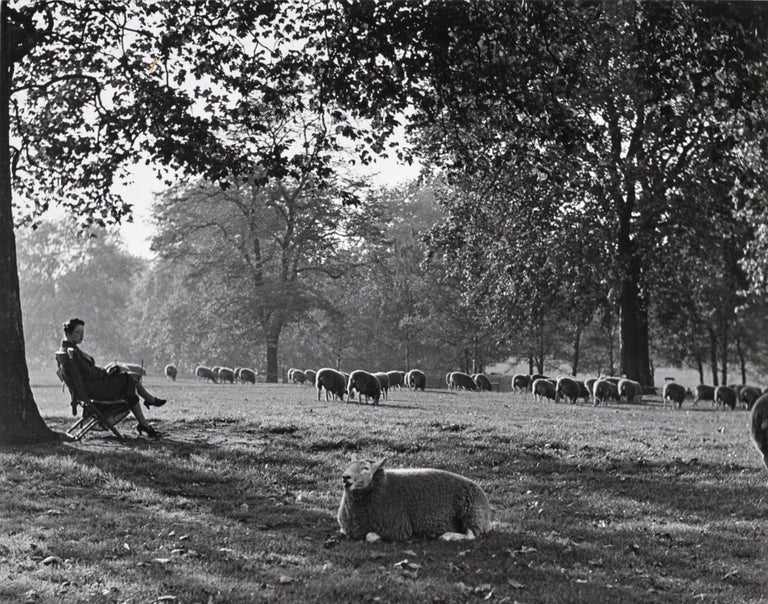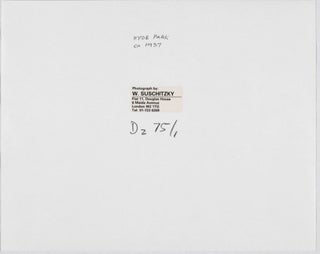Hyde Park, London, 1934
c 1937. Gelatin silver print. Vintage. 11 7/8 x 14 5/8 in (302 × 372 mm); archivally matted and framed. The verso with mounted photographer's label with address "Flat 11, Douglas Hous, 6 Maida Avenue, London W2 1TG, Tel: 01-723 6269", hand annotated "Hyde Park, ca. 1937." Nearly pristine condition.
[Michael Omasta, et al. Wolf Suschitzky: Seven Decades of Photography (Vienna: Synema, 2014), ill. p. 176].
An atmospheric and magical photo by master of the lens, photographic and cinematic, that captures a tranquil corner of Hyde Park. As Suschitzky himself said about this photo "In those days grazing sheep were employed to look after Hyde Park's well-kept lawns." (Omasta, p. 176) In the 1920s and 1930s, sheep were routinely introduced into London parks to keep the grass under control and reduce mowing costs. Shepherds competed for the privilege of grazing their flocks on Hyde Park, Kensington Gardens, Clapham Common, and their flocks could be seen traversing the busy streets of the city.
Born in Vienna in 1912 Wolfgang Suschitzky was not only an established documentary photographer but also a cinematographer who worked on over 200 feature films, TV productions, and documentaries. His father was a social democrat of Jewish origin, who opened the first social democratic bookshop in Vienna (later to become a publisher), and Suschitzky was born in the apartment above the bookshop. His photographer sister Edith Tudor-Hart (1908-1973) convinced him to set aside his passion for zoology and study photography, which would make him a better living and in 1934 he left for London, where she lived.
Before the Second World War, he began working for the distinguished documentarist Paul Rotha: "I showed him some things, and he gave me a job on some zoo films. That suited me, because when I was growing up in Vienna, I always wanted to be a zoologist." He was a probably best known for his work with Paul Rotha and for his work in the film "Get Carter". He also worked on propaganda films such as Report on Steel (1948) which promoted the steel industry: "They wanted to make films that were useful to society, and so I was really glad that I could join them. We made films on housing problems, on problems in hospitals and down coal mines, so I got into places other people normally never go."
Suschitzky's work is socially engaged and always shows integrity and compassion for his subjects. His work is in the collections of Tate Britain, National Portrait Gallery, Victoria & Albert Museum, Museum of London, National Galleries of Scotland, Austrian Cultural Forum, and other institutions worldwide. In 2012 BAFTA presented Suschitzky with a Special Award for a Creative Contribution to Cinema. He was the father of cinematographer Peter Suschitzky and classical musician and writer, Misha Donat.
Condition: Fine.
Item number: 479
Price: $3,250.00
Share:

